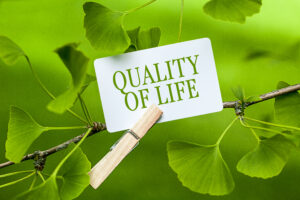Home » Information About Minnesota » Measuring Quality of Life
Measuring Quality of Life
The outcomes of a positive support practice will include assessment of changes related to the quality of life of persons receiving services. Individuals have always been interested in finding happiness and sense of well-being in their lives. Quality of life refers to the extent to which a person is experiencing positive life experiences across home, school, work, and community settings. Measuring the quality of a person’s life is challenging to assess because everyone is unique.
Quality of Life Domains
There are factors within a person that can impact feelings of well-being. Researchers have used quality of life to describe the different domains or areas of well-being that can be considered. For example, emotional wellbeing is related to the positive emotions you have and how empowered you feel. The list on the right provides a short description of common quality of life domains.
Multiple Methods for Evaluating Quality of Life
Most teams evaluating qualify of life use multiple methods. Tools used to assess quality of life changes related to different positive support practices are used to assess an individual person’s progress in improving life outcomes. Interviews with a person and surveys can be used to describe how a person feels about changes in quality of life.
Strategies for Gathering Quality of Life Information
Sometimes a person cannot communicate how they feel about their own quality of life. It is sometimes necessary to ask people who know a person really well to complete different types of quality of life interviews or surveys. This is considered a “proxy measure” since the goal is to try to understand quality of life from the person’s own unique perspective.
Data can be collected using observational methods. Observation data may be collected based on improved use of social, cognitive, and communication skills. A summary of the number of important social interactions or meaningful friendships might be included in a quality of life assessment.
Indicator Measures Across Domains
Each person and their team identifies “indicator measures” for each qualify of life domain. Indicator measures help to define a domain allowing the team to select a measurement for evaluation. In school, personal development may be measured by progress made at school in specific academic area. A team may decide to measure emotional well being by using a survey tool to assess levels of self-confidence or decreases in stress.
Teams review quality of life at an organizational level by monitoring progress across all individuals receiving services. This provides the team with a way to observe any patterns that may be occurring at an organizational level. For instance, certain domains of quality of life may not be showing progress across most people receiving services. This may indicate that training is needed to introduce new strategies that directly address that particular domain.

Quality of Life Domains
- Emotional Well-being
Feeling Empowered and Experiencing Positive Emotions - Interpersonal Relations
Opportunities for Friendship and Intimacy, Quality of Interactions With Others - Material Well-being
Ownership of Possessions, Meaningful Employment - Personal Development
Opportunities for Education and Habitation - Self-determination
Setting Personal Goals, Making Decisions About Important Life Choices - Physical Well-being
Optimal Health Care and Nutrition, Mobility & General Wellness - Social Inclusion
Natural Support Networks Inclusive and Integrated Environments - Rights
Experience of Ownership of Key Items and Property, Allowed Due Process, Privacy and Barrier Free Environments are Available.

